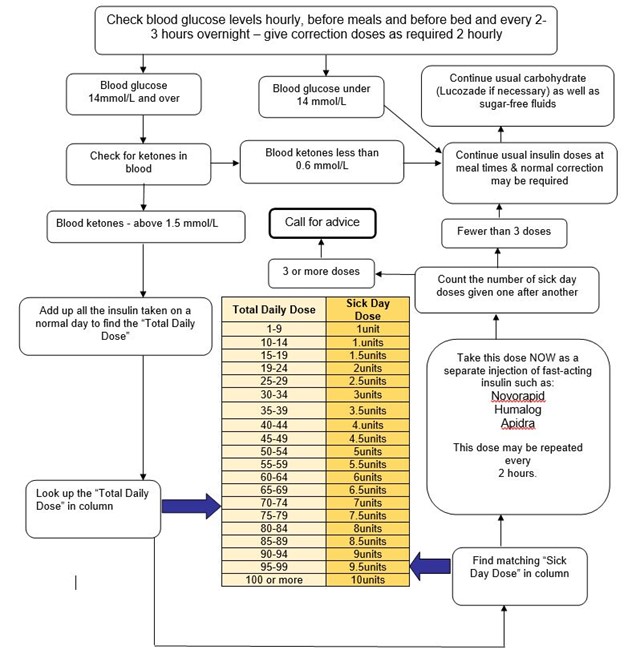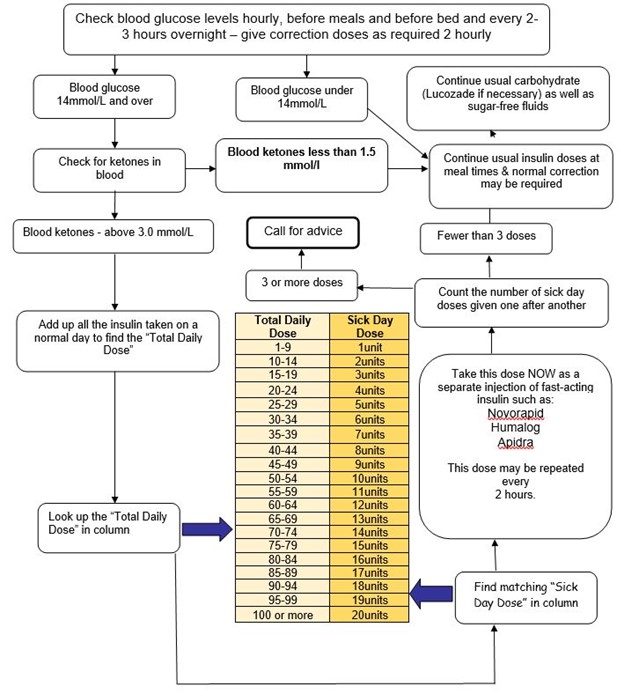Diabetes Education – Sick day rules
Aim of Tutorial:
To learn how to manage diabetes when you are unwell
Objectives of Tutorial:
- To understand how ketones can quickly develop during sickness
- To know how and when to test for ketones
- To be able to follow the flow charts enclosed in this information booklet
Managing sick days with high blood glucose levels and ketones
Sickness is an unavoidable part of everyday life. However for a child or young person with diabetes it can be a difficult time. Even a minor illness can be a problem when you have diabetes.
This information sheet has been written to help you manage “sick days”.
Effect of illness’ on blood glucose
- Low blood glucose levels
- High blood glucose levels
- High blood glucose levels with ketones
1.Low Blood glucose during illness
This may occur if you get sickness and diarrhea
How to treat:
- Give your usual insulin if your blood glucose level is over 5 mmol/L (100mg/dL)
- Have your carbohydrates as sugary drinks if you don’t feel like eating
- If blood glucose levels are less than 5 mmol/L (100mg/dL) - give background insulin only and have 20 grams carbohydrate as a sugary drink
- Check blood glucose levels every 1 - 2 hours
- Reduce next background insulin dose by 50% (half normal dose) if you struggle to keep your blood sugar level over 5 mmol/L (100mg/dL)
2.High blood glucose levels during illness (see flow chart below)
High blood glucose levels occur during most illness’

What happens if you get Diabetic Ketoacidosis (DKA)?
- Blood glucose is high - you are thirsty and start to pass lots of urine.
- This makes your body very dry (dehydrated)
- Your body makes ketones
- Ketones can make you vomit
- Ketones can give you stomach ache
- Ketones make you breathless
- People can smell ketones on your breath - it smells like acetone.
- Ketones make you drowsy and may sometimes lead to unconsciousness
DKA is a serious problem which can make you very ill, You may need to be looked after in hospital
Sick day rules and getting rid of ketones
- Never stop the normal insulin, even if you are eating less than normal. When you are ill the body needs insulin to use glucose and to get rid of ketones.
- Do more blood tests to see what is happening to the blood glucose levels. It may be necessary to check the blood glucose levels 2 – 3 hourly until ketones are no longer present and blood glucose is back to target.
- Check the blood for ketones when the blood glucose is greater than 250mg/dl (14mmol/L)
- Drink lots of water, sugar free/no added sugar drinks or diet fluids to wash the ketones away.
- Keep eating carbohydrate foods.
- When you are unwell you still need food for energy. It is important you get enough carbohydrate for the body to use for energy, to prevent starvation ketones.
- It is important for you to have carbohydrate foods, if you are unable to manage your usual meals and snacks you should replace these with glucose containing food and drink which is easy to consume.
- You should only have the sugar containing drinks to replace carbohydrate foods. At other times you need to have water or sugar free drinks or rehydration fluids.
- Examples of carbohydrate food and drinks to have when you are unwell are; sparkling glucose drinks, ordinary cola or lemonade, sugar containing drinks e.g. Ribena, sports drinks, ordinary squash, soups, toast, jelly and ice cream
Give extra fast acting insulin if required to get rid of the ketones
Remember you can prevent DKA by following the advice and asking for help if it is not working.
High blood glucose during times of illness
- ALWAYS give your insulin. (The dose may change depending on how the illness affects your blood glucose levels)
- Test your blood glucose level before every meal or every 2 hours
- If your blood glucose is more than 250mg/dl (14 mmol/L) test blood for ketones
- Drink plenty of sugar free drinks (at least 1 glass of water per hour)
High blood glucose and raised ketones during times of illness
|
If you have a blood glucose over 250mg/dl (14 mmol/L), but ketones of 0.6mmol/L - 1.5 mmol/L use correction doses to manage blood glucose levels but keep checking for ketones to ensure they do not go above 1.5mmol/L |
|
If the blood glucose is above 250mg/dl (14mmol/L) and blood ketones are 1.5 mmol/L or more, you will need extra insulin refer to diagrams on the next 2 pages ‘what to do when unwell’. |
If you are vomiting or find it difficult to control your blood sugar: don’t wait - phone the diabetes team/hospital.
|
Blood Ketone Level |
What it Means |
|
Below 0.6 mmol/l |
|
|
0.6 to 1.5 mmol/L |
Readings between 0.6 and 1.5 mmol/L may indicate the development of a problem that may require medical assistance. Follow the instructions above
|
|
1.5 – 3.0 mmol/L |
Readings above 1.5 indicate you may be at risk of developing diabetic ketoacidosis or DKA. Contact your health care provider immediately for advice |
What to do when unwell or blood glucose over 25omg/dl (14 mmol/L) and blood ketones between 1.5 and 3.0 mmol/L

Call for advice if any of the below:
- Requiring 3 or more sick day dose in a row
- Vomiting persists and blood ketones still above 1.5mmol/L
- Child looks ill (sleepy, dry mouth, sunken eyes
- YOU ARE WORRIED FOR ANY REASON
What to do when unwell or blood glucose over 14 mmol/L and blood ketones above 3.0 mmol/L

Call for advice if any of the below:
- Requiring 3rd sick day dose in a row
- Vomiting persists and blood ketones still above 1.5mmol/L
- Child looks ill (sleepy, dry mouth, sunken eyes
- YOU ARE WORRIED FOR ANY REASON
Try to answer the questions below :
1. Your ketones are 1.4mmol/L and your blood glucose is greater then 250mg/dl (14mmol/L)
When would you next test?
A) Blood glucose
B) Ketones
2. Your Ketones are 2.8 mmol/L and your blood glucose is 400mg/dl (22mmol), you have just eaten 20 grams of carbohydrate.
|
What is your total daily dose of Insulin? |
|
|
Work out your sick day dose - see flow chart |
|
|
How much insulin would you give for the carbohydrate eaten |
|
|
How much insulin would you give in total? |
|

